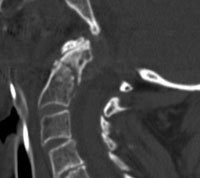Researchers find 9.6% neurological deficit rate with type 2 odontoid fractures
 Kris E. Radcliff |
SAN DIEGO — A neurological deficit in combination with acute type 2 odontoid fractures was associated with six-fold increased mortality and an elevenfold increased risk of respiratory distress according to the results of a study of patients treated at a regional spinal-cord injury referral center and tracked in a prospectively collected database.
“These results have led us to carefully monitor patients with neurological deficits for signs of respiratory distress and consider early ventilatory support,” Kris E. Radcliff, MD, told Orthopedics Today. He presented the results at the 2011 Annual Meeting of the American Academy of Orthopaedic Surgeons, here.
Radcliff and colleagues, who are affiliated with the Rothman Institute and Thomas Jefferson Medical Center’s spinal cord injury center in Philadelphia, compared their study population of patients to an intact cohort of 188 patients from Thomas Jefferson with the same fractures but intact neurological examination.
“There was a 9.6% incidence of neurological deficit in our series of patients attributable to a type 2 odontoid fracture,” Radcliff said in his presentation.
Focus on survival
Few studies focus directly on outcomes in patients with these fractures relative to the extent of their neurological injury, according to Radcliff. “The purpose of our study is to look at the outcome and particularly the in-hospital survival and outcome of patients with a neurological deficit and type 2 odontoid fractures,” he said.
|
|
Images: Radcliff KE |
The researchers hypothesized neurological deficits would be associated with increased complications and patients with a deficit would have a notably worse prognosis than those without.
Of patients with an odontoid type 2 fracture entered in the database between 1985 and 2008, researchers identified 20 patients with acute fractures and neurological deficits. When the researchers compared that group’s comorbidity on the Charlson Comorbidity Index and other demographic and clinical factors to those of similar, but neurologically intact patients from another study, they found the deficit group included more men and a higher percent of them had high-energy injuries. However, the groups were otherwise balanced in baseline comorbidities.
Respiratory complications seen
“The most common presentation of neurological deficit was complete spinal cord injury with ASIAA [American Spinal Injury Association] quadriplegia and 75% of these patients were treated nonsurgically,” Radcliff said during his presentation.
He noted there was a higher rate of in-hospital complications in the deficit group.
“Interestingly, the most common complication is a respiratory complication which occurred in more than 90% of the patients with a neurological deficit and the mortality in neurological deficit patients is significantly higher than those in the neurologically intact cohort; 50% vs. 12%,” Radcliff said.
Based on this research, Radcliff and colleagues concluded there was a high risk of an early and rapid clinical decline when patients present with neurological deficits. – by Susan M. Rapp
Reference:
- Patel AA, Smith H, Radcliff KE, et al. Spinal cord injury associated with Type II odontoid fractures: A retrospective cohort analysis. Paper #24. Presented at the 2011 Annual Meeting of the American Academy of Orthopaedic Surgeons. Feb. 15-19. San Diego.
- Kris E. Radcliff, MD, can be reached at 2500 English Creek Ave. #602; Egg Harbor Township, NJ 08234; 609-569-1000; e-mail: radcliffk@gmail.com.
- Disclosure: Radcliff has no relevant financial disclosures.












